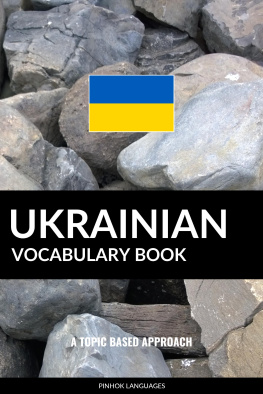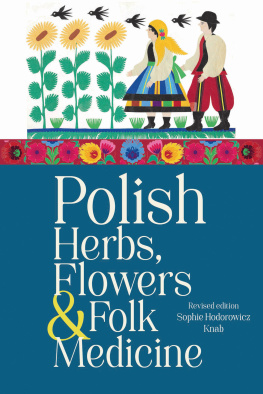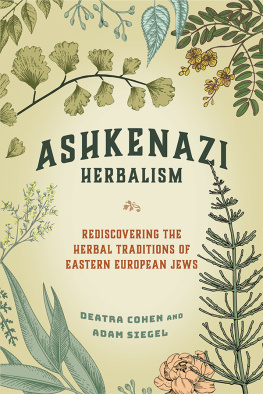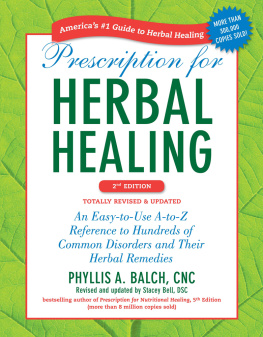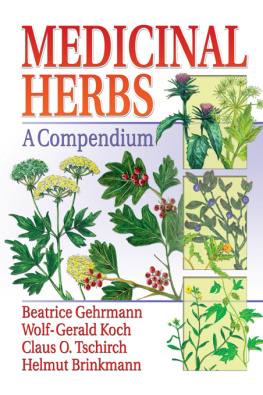ACKNOWLEDGEMENTS Lina Stenemo; Marco Anganaro; Jzef Godlewski from Herbapol, Poland; Beata Palfalvy, St Steven University, Hungary; Cailleau Herboristerie, France; George Sfikas, Dimitris Loupis; Faruk Tuncay; A. Minardi & Figli, Italy, for help with herbal identification and to Panos, Natalie, Alexandra, Diana and Titi for translating How to use the Lexicon. I am very grateful to all for the help they gave me. ABOUT THE AUTHOR Kate Koutrouboussis was born and brought up in London by an Italian father and a Hungarian mother. She acquired a number of further languages by extensive travel, and by marrying a Greek, and after taking a course in Herbal Medicine in London she saw an opportunity to combine her interests in languages and plants. She lives in Greece.
How to use the Lexicon I f you are an English speaker and want to know the Hungarian word for Shepherd's Purse, turn to the and find Shepherd's Purse. Beside it you will find a number, in this case 137. Next, go to number 137 in where the plants are listed alphabetically under their Latin names and below will be the name of the plant in the various languages. E = English; F = French; G = German; S = Swedish; Sp = Spanish; I = Italian; Gr = Greek; H = Hungarian; P = Polish; T = Turkish The same system applies to any of the other languages in this Lexicon. The purpose of this book is to help the herbal traveller, from students to professional biologists in the field, herbal retailers and wholesalers, people living away from their own country and medical herbalists. I have mainly kept to herbs which grow in Europe and the Mediterranean but have included some from the rest of the world which are commonly used in Europe.
I anticipate that this Herbal Lexicon will be very useful, not only for Europe and the Mediterranean but for Asia, Australia, and the Americas. Comment utiliser le Lexique S i vous tes un locuteur francais, desirant connaitre le mot hongrois pour Bourse--pasteur, allez dans ou les plantes sont listes alphabetiquement sous leur nom en latin et en dessous vous trouverez le nom commun de cette plante dans la langue recherche. E = Anglais; F = Franais; G = Allemand; S = Sudois; Sp = Espagnol; I = Italien; Gr = Grecque; H = Hongrois; P = Polonais; T = Turc Le hongrois n'est qu'un exemple. Le mme systme s'applique toutes les autres langues de ce Lexique. Le but de ce dictionnaire est d'aider le voyageur botanique, les etudiants, les biologistes professionnels, les herboristes, les marchands d'herbes medicinales, ou les personnes voulant connaitre l equivalent en vocabulaire des herbes de leur propre pays. Je me suis interesse principalement aux herbes qui poussent en Europe et autour de la mditerrane, mais j'ai rajoute celles qui sont connues dans le monde entier et frquemment utilises en Europe.
Pour conclure, je pense que ce dictionnaire botanique d'herbes sera trs utile, non seulement pour les Europens mais aussi pour les habitants d'Asie, des Etats Unis ou de l'Australie. Gebrauchsanleitung D eutschsprachige, die das ungarische Wort fr Hirtentschel wissen mchten schlagen das suchen. Dort sind die Pflanzen nach ihrem lateinischen Namen alphabetisch angeordnet und darunter die Pflanzennamen in den verschiedenen Sprachen. E Englisch; F Franzsisch; G Deutsch; S Schwedisch; Sp Spanisch; I Italienisch; Gr Griechisch; H Ungarisch; P Polnisch; T Trkisch Ungarisch wurde als Beispiel verwendet, das gleiche Prinzip gilt aber auch fr alle anderen Sprachen. Dieses Buch soll eine Hilfe fr den botanisch interessierten Reisenden sein. Es richtet sich an Studenten und Botaniker und Biologen, Gewrzhndler und Grosseinkufer, Leute, die vorbergehend in einem andern Land wohnen und Spezialisten fr medizinische Kruter.
Es werden hauptschlich Kruter, die in Europa wachsen, aufgefhrt, aber auch einige aus andern Kontinenten, die in Europa bekannt sind und verwendet werden. Zum Schluss mchte ich sagen, dass ich glaube, dass dieses Kruterlexikon nicht nur fr Interessierte aus Europa und den Mittelmeerraum ntzlich sein wird sondern auch fr Interessierte aus Asien, Australien und Amerika. S hr anvnder du lexikonet O m du r en svensk hgtalare och vill veta det ungerska ordet fr Lomme, vnd dig till det och listat bredvid H s kommer du att se Psztortska som r det ungerska namnet p Lomme. Om du bara vet, gr det botaniska namnet till del ett dr plantorna listas alfabetiskt under deras latinska namn och nedan kommer det att vara plantans namn p de olika sprken. E engelska; F franska; G German; S svenska; Sp spanska; Jag italienska Gr grekiska; H Ungerska; P Polska; T turkiska. Ungarn r bara ett exempel.
Samma system gller fr ngot av de andra sprken i det hr lexikonet. Syftet med denna bok r att hjlpa vxtbaserade resenrer. Frn studenter till professionella biologer inom fltet, vxtbaserade detaljhandlare och grossister, mnniskor som bor ifrn sitt eget land och medicinska herbalister. Jag har huvudsakligen hllit p rter som vxer i Europa och Medelhavet men har inkluderat ngra frn resten av vrlden som vanligtvis anvnds i Europa. I slutndan anser jag att denna vxtbaserade lexikonet kommer att vara mycket anvndbar, inte bara fr Europa och Medelhavet, utan fr Asien, Australien och Amerika. E Ingls; F Francs; G Alemn; S Sueco; Sp Espaol; I Italiano; Gr Griego; H Hngaro; P Polaco; T Turco. E Ingls; F Francs; G Alemn; S Sueco; Sp Espaol; I Italiano; Gr Griego; H Hngaro; P Polaco; T Turco.
El hngaro es solo un ejemplo. El mismo sistema se aplica a cualquiera de los otros idiomas en este lxico. El propsito de este libro es ayudar al viajero herbal. Desde estudiantes hasta bilogos profesionales en el campo, minoristas herbarios y mayoristas, personas que viven fuera de su propio pas y herbolarios mdicos. Principalmente me he limitado a las hierbas que crecen en Europa y el Mediterrneo, pero he incluido algunas del resto del mundo que se usan comnmente en Europa. Para terminar, creo que este lxico herbal ser muy til, no solo para Europa y el Mediterrneo, sino tambin para Asia, Australia y Amrica.
Come usare il Lessico S e parlate Italiano e volete sapere la parola ungherese per Borsa del pastore, andate dove le piante sono elencate in ordine alfabetico sotto i loro nomi in Latino e sotto il nome della pianta nelle varie lingue. E Inglese; F Francese; G Tedesco; S Svedese; Sp Espagnolo; I Italiano; Gr Greco; H Ungherese; P Polonese; T Turco. L'ungherese solo un esempio. Lo stesso sistema si applica a qualsiasi altra lingua in questo Lessico. Lo scopo di questo libro quello di aiutare l'erborista. Dagli studenti ai biologi professionali nel proprio campo, dai dettaglianti ai grossisti, persone che vivono lontano dal loro paese e medici erboristisi.
Sono riferito principalmente alle erbe che crescono in Europa e nel Mediterraneo ma ho incluso alcune dal resto del mondo che sono normalmente usate in Europa. In conclusion, penso che questo Lessico Erbale sar molto utile, non solo per l'Europa e il mediterraneo ma anche per l'Asia, Australia e le Americhe. , ( ) . E ; F ; G ; S ; Sp ; I ; Gr ; H O; P ; T . . , , . , . , , . , , .
Hogyan hasznljuk a lexikont H ogyha magyar anyanyelv vagy s megszeretnd tudni mi A Psztortska angol neve, akkor keresd meg a a msodik rszben s talld meg Psztortska. A sz mellett tallsz egy szmot, ebben az esetben 137. Kvetkez lpsknt lapozz a 137-es szmhoz az els rszben. A latin nv alatt
Next page
